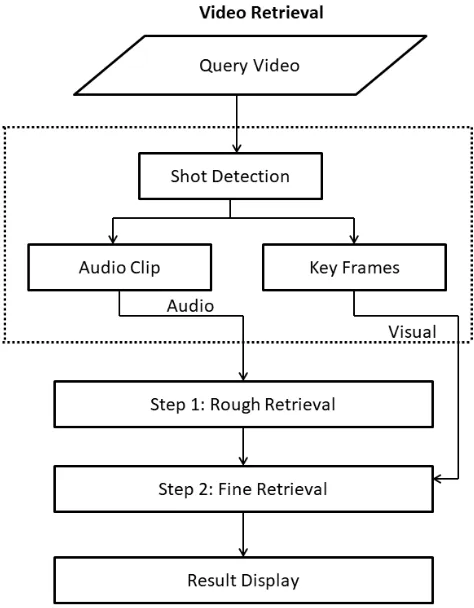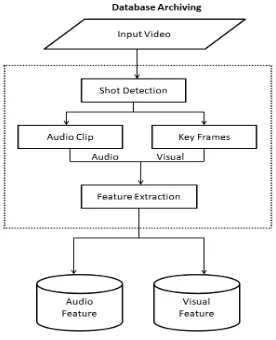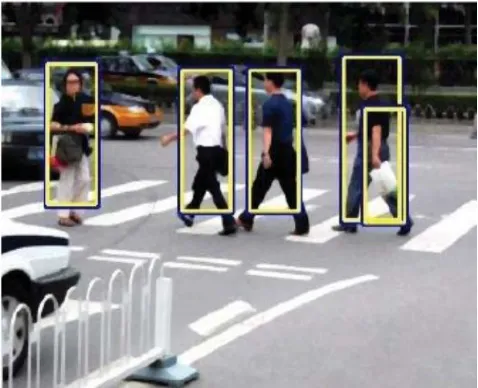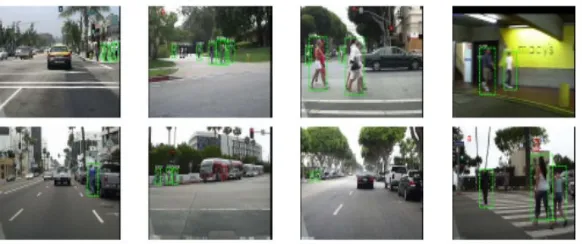6
I
January 2018
A Study of Real Time Human Detection Data
System from Dynamic Visuals through QEVR and
PL-SVM Techniques
Aurobind. G1, Barath. A2, Vijiyakumar. K3
1
Virtual Knowledge Network (VKN) National Institute of Mental Health and Neuro Sciences (NIMHANS) Bengaluru, India
2, 3
Dept. of Information Technology Manakula Vinayagar Institute of Technology(MVIT)Pondicherry, India
Abstract: The computer vision and pattern recognition community are the most important research area which increases the human detection of images mainly because of its applications like driving assistance system, content-based image retrieval and video surveillance. Digital image processing mainly deals with changing the nature of the image as required. This paper a video scene retrieval algorithm based on the query by example video retrieval (QEVR). The prior work on video analysis based on extracting visual features, a special framework is used for video retrieval in two stages using query by example which uses both the audio and video. The dynamic video into audio and visuals are separated by query by example. Again the visual is given as input to the PL-SVM technique to detect the human from the visuals. The proposed approach delivers good performance in the image retrieval.
Keywords: Human Detection, PL-SVM, QEVR, Image retrieval.
I. INTRODUCTION
An efficient technique for human detection has a special interest in computer vision because it involves people’s locations and movements. For the last few years, the problem of detecting humans in a single image has been received a keen interest. The challenging task is variations in illumination, shadows, and pose, as well as frequent inter- and intra-person occlusion render. Two main approaches to human detection have been explored longer. The detected parts of the human body are combined according to a prior human model which is a generative process consists of the first class of methods. The second class method has a purely statistical analysis to join a set of low-level features within a detection window which has the window as containing a human or not. The method used in this paper belongs to the latter class. The grids of Histograms in an Oriented Gradient (HOG) descriptors are for human detection[1], and obtained good results on multiple datasets. The HOG feature looks as a spatial distribution of edge orientations. Analysis gives an information such as the homogeneity of human color, particularly skin color, clothing, typical textures of human clothing and background textures complement the HOG features efficiently. When combined, this descriptors helps to improve the detection results significantly.
II.REVIEWOFRELATEDWORKS
In the existing system, the human being is detected from the dynamic visuals. The piecewise linear support vector machine (PL-SVM) is used for human detection. In this technique, there are two parts[2]. The first part consists of Block Orientation (BO) features extracted on a whole cell; it is discriminative between stroke and region patterns. It can depress noise and local texture. The second part consists of Histogram of Oriented Gradients (HOG) features for human detection by some stroke patterns like tree branches and railings may be detected as a parts of human bodies. With the first part (BO features) as a complement to the second part (HOG features)[3].Thus it can reduce these false detections. Finally, the humans are detected by PL-SVM model.
III. PROPOSEDSYSTEM
humans very simple and fast. Moreover, when we need to detect multi-posture and multi-view of humans simultaneously in a video system[4],thus the performance of a linear SVM often drops significantly. It is observed that human being in continuous view and posture variations to form a manifold, which is difficult to be linearly classified from the negatives.
Figure 1. System Architecture
A. Training Image
Human being samples are classified into subsets with a K-means[5] clustering algorithm. All negatives are assigned to each of the subsets before training for a manifold embedded space. When subsets are get initially clustered, with smaller differences the human samples are assigned to the same subset, rather than a random one it leads to the better sample division.
To construct the human manifolds, the local linear embedding (LLE) algorithm is employed. In this LLE algorithm there will be a set of human samples in the high-dimensional feature space[6], algorithm starts with finding the nearest neighbours by using the Euclidean distance. Then the algorithm is used to represent each original sample which identifies the optimal local convex combinations of the nearest neighbours.
(b)
Figure 2: Training convergence of the PL-SVM with HOG features
B.Sample Division into Subsets
Here it shows the internal work modules of the functioning system
Figure 3: 1st step method for QEVR
C. Query Video
It is a Video you already have. A symbolic description of what you want. E.g. Speech of Ted Talks about Technology[7]
D. Shot Detection
[image:4.612.189.426.243.547.2]Figure 4: 2ndstep method for QEVR
E. Two-Step Retrieval
The two stages in the video retrieval scheme are: offline database archiving and online video retrieval. The earlier one is in archiving stage, which are mainly used to support the shot-based video retrieval [9], thus the video processing is essential segment for using shot cut technique and extract audio-visual features. The video retrieval stage are the same as those for the database archiving stage for video preprocessing. We use the latter one. First the audio features are mapped into a subspace for rough retrieval and after that results are optimized by visual features.
A two-step retrieval method is conducted after the feature extraction: the first step is rough retrieval based on audio features, the aim is to narrow the scope of target videos by excluding irrelevant videos[10]; the second step is to refine retrieval, which is to confirm the final result videos using similarity measure method. Lastly, the system returns the result videos.
1) Rough Retrieval Based on Audio Feature:The audio signals were segmented at 30ms/frame with Hamming window, which is the basic unit for feature extraction. And then, the audio features are used to construct feature vector for audio frame. The audio samples were collected with 44.1 kHz sample rate[11], stereo channels, and 16 bits per sample. Feature analysis is conducted on each clip. The aim of rough retrieval is to narrow the scope of objective videos in database utilizing the audio feature vector mentioned above.
3) Visual Features at Key Frame Level: We segment video clips into shots and extract representative frames from each shot. The key frames of a shot reflect the characteristics of the video to some extent. Traditional image retrieval techniques can be applied to key frames to achieve video retrieval. The advantages of color histogram are that it is invariant for translation and rotation of the viewing axis. Texture feature describes the spatial correlation between pixels, compensating for this shortcoming.
The color basic properties are emphasized and then the color histogram bins are chosen as 180. Here, we adopted eight indicators extracted from GLCM[13], namely, the mean and standard deviation of energy, entropy, and contrast and inverse difference moment.
Textural uniformity of an image is measured in terms of energy level[14]. Energy reaches its highest value when gray level distribution has either a constant or a periodic form. Entropy measures the disorder of an image and it achieves its largest value when all elements are in GLCM.
F. BO and HOG Feature Extraction
The first order gradient are related to edge information.To obtain them, we need to compute the first order gradient at each pixel, aggregate the gradients to the corresponding cell, make a histogram on each cell, normalize the histogram along four directions, and finally concatenate all the normalized histograms to get the feature vector. It has two improvements from the original HOG: 1. The cell feature normalized along four directions are summed together, instead of concatenation, which reduces the dimensionality of feature vector to one-fourth; 2. A 4-dimensional texture feature vector is added for each cell. Similarly in BO too all cells in the image are divided into up down and left right sub shells[15]. We extract the features for all INRIA images which contains positive images with human object and negative images without human, and save those features in our database which will be used during SVM classification.
G. Two Stage PL-SVM classifications
In each section, the Block Orientation features are extracted and tested with the PL-SVM in the earlier stage. Then the window is classified as a human, and the HOG features[16] will be extracted and tested with the PL-SVM of the next stage to finally decide whether it is a human being or not.
H. Integration of Positives
[image:6.612.188.427.511.705.2]Three datasets are used for integration of positives. The first case is the SDL set of data with 7550 human samples and 5769 negatives[17][18]. The window size on image is chosen randomly which slides over whole image. It may happen that for chosen window size no human object is classified in any window because of size uncertainty of object, so keeping window size same, image size is reduced and this process continues till complete human object or highest classification accuracy is not achieved. We have tested our proposed features set on many INRIA images and compared the F-measure value with HoG+BO and HoG+HoC+HoB features set. A significant improvement from previous work is achieved. The comparative table of F measure of four test images considered in this paper.
IV. HUMANDETECTION
The proposed QEVR in PL-SVM is incorporated with two kinds of features for human detect. The detection performance is improved by cascade detector.
A. Feature Representation
First calculate the gradient orientations of the pixels in the cells to extract HOG features. By using gradient orientations as a features, we calculate a 9-dimensional histogram of each cell[19]. A 36-dimensional feature vector, can be normalized by dividing each feature bin with the vector module for each block. Every sample corresponding to a 3780-dimensional (BO), derived as a complement to the HOG features for human being visual detection. The total no of 420 cells are first divided into left-right and up-down sub-cells and then the horizontal and vertical gradients of the cell are calculated by
where Ic(X) is one of the R, G and B color values at pixel X. The BO features are the normalizations of Bh and Bv:
ℎ= ℎ⁄ + ℎ +
= ⁄ + ℎ +
where ε is a constant to reduce noise effect. Its value is set as 10.0 × (the size of a cell), empirically. It is discriminative between stroke and region patterns and can depress local texture and noise thus BO features are extracted on a whole cell [20]. The HOG features are indistinctive so that it can be seen that for the stroke and region patterns (with noise), while the BO features can distinguish one from the other. In some stroke patterns such as tree branches and railings maybe detected as parts of human bodies the HOG features are used for human detection. We can reduce these false detections with the BO features as a complement to the HOG features.
B. Cascade Detector with QEVR in PL-SVMs
We train two QEVR in PL-SVM models, one with the BO features and the other with the HOG features with a given set of training samples[21]. In the preprocessing we apply a histogram equalization and median filtering of radius equal to 3 pixels on the test image first for the detecting procedure. The resulting image pyramid, is repeatedly reduced in size by a factor of 1.1. From each layer of the pyramid, the sliding windows are extracted[22]. In each window, the BO features are extracted and tested with the PL-SVM in the earlier stage. Finally decide whether it is a human or not the HOG features will be extracted and tested with the QEVR in PL-SVM of the later stage so that the window is classified as a human. In the first stage, If the window is classified as non-human so the second stage will not be used. Most of the windows are rejected at the first stage because it leads to high detection efficiency. We can use a small threshold for the QEVR in PLSVM in the first stage,so most of the positives pass through the second stage. By Adjusting the threshold value in the second stage it can balance the detections of false positives and false negatives.
V.EXPERIMENTS
The human detection which is proposed in PL-SVM is to be compared with the linear SVM and three state-of-the-art SVMs, kernel SVM[23], profile SVM and latent SVM. The algorithm I is designed for linear classification of a large amount of data where the local linear SVMs is in the iterative. Integral image methods on color and gradient images has to improve the efficiency are calculated by using BO and HOG features. Three datasets are used in the experiments. The SDL dataset with 7550 human samples and 5769 negatives, which are publicly available in the first one. Totally there are 258 images for testing. The second one which consists of TUD-Brussels dataset, with 1167 training positives, 6759 negatives, and 508 test video frames. The number of training
ℎ= max
positives is doubled by flipping the images horizontally in the experiment. The third one is the INRIA dataset, which is used for human detection evaluation in recent times. It has a training set which includes 2478 positives and 12180 negatives boosted from 1218 person-free photos with 288 test images. The INRIA and SDL datasets consists of human samples for views and multi-postures. The multiple views and postures captured from a practical driving platform has TUD-Brussels with human samples. This large amount of samples are able to construct different manifolds which covers all views and postures with datasets.
A. Parameter Setting of QEVR in PL-SVM
We design a ten-fold cross validation, to determine the piecewise number K of a QEVR in PL-SVM. The K with the highest accuracy is selected for testing Cross validation accuracies with different piecewise numbers. The SDL dataset should be six, and TUD-Brussels and INRIA datasets[24] are both four with respective to piecewise number. The training convergence of the PL-SVM is also validated by our technique. There are large ratios of samples being reassigned in the first iteration. After about ten iterations, showing the convergence of the training procedure, the ratios are close to zero. Showing that in the PL-SVM training, the division of the samples is significant, we can see that the samples in each subset have similar appearances[25].These subsets used for both the training and detection performances, can be improved in PL-SVM models.
B. Comparison of QEVR in PL-SVM With Other SVMs
[image:8.612.109.486.382.622.2]To compare three SVM methods with the proposed QEVR in PL-SVM, we design another ten-fold cross validation experiment to assess the QEVR in PL-SVM classification method. The proposed PL-SVM outperforms the linear, kernel and profile SVMs can be seen in all the datasets. On an average of 1.5% higher than the PL-SVM method, which builds a histogram intersection kernel and reports good human classification performance and the accuracies of the QEVR in PL-SVM are 99.19%, 99.51% and 99.03% on the three datasets[26], are taken respectively. As the 1.0–2.0% accuracy improvement is significant because it is more and more difficult to improve the cross validation accuracy when it is close to 100%. The higher performances are observed in most cases where both HOG features and BO features are used.
Figure 6: Determination of the piecewise number K by cross validation
K << S[28]. When performing human detection, the first PLSVM uses the BO features, which have a much lower dimensionality than the HOG features.
[image:9.612.180.431.220.507.2]In our proposed method, the training and detection efficiency is tested and compared with other four SVM methods. When compared with other techniques, the linear SVM, QEVR in PL-SVM is more efficient in both training and testing than the others. In training, the QEVR in PL-SVM is about three times as fast as Intersection Kernel SVM and latent SVM. On an average on a PC with an Intel CORE i5 CPU (fastest among all) it runs at a speed about 2 images per second while performing detection. The usage of BO features in the cascade detection boosts the detection speed from 0.33 images per second to 2 images per second which can be seen from the last column. It has an speed which is about four times as fast as the state-of-the-art latent SVM when compared to other methods.
Table I. Cross Validation Accuracy Of Four Svm Methods
Classification Methods Cross Validation Accuracy on INRIA, SDL, and TUD Datasets Average Cross Validation Accuracy
Kernel SVM [20]
97.21% 98.25% 97.10%
97.52%
Profile SVM [27]
97.62% 98.51% 97.36% 97.83% PL-SVM [1] 98.79% 99.13% 98.53% 98.82%
QEVR in PL-SVM
99.19% 99.51% 99.03%
99.30%
C. Human Detection Performance
Figure 7: Humans Detected from the surveillances cameras
Indicating that BO-HOG features are more effective than HOG features only for human detection, where both BO and HOG features are used, even higher performance is obtained. when FPPI is lower than 0.1, the overall QEVR in PL-SVM works better than latent SVM on the TUD Brussels dataset and the SDL dataset. When images contain low-resolution human regions in clutter backgrounds, with low false detection rate which shows an advantage of PL-SVM. Since most of the human objects in this dataset are of high resolution and QEVR in PL-SVM has higher performance than PL-SVM on the INRIA dataset which provides what latent SVM exactly in its part-based detection strategy. The human regions is often low, where humans are usually far from the camera in many practical applications, such as visual surveillance or driving assistant systems.
Most of the humans are correctly located with few false positives which are detection examples. The human objects has more number of multi-views with posture variations. The proposed QEVR in PL-SVM can correctly capture object patterns of large variations simultaneously with the strategy of piecewise linear SVM models combined and almost all of them are correctly located. It is found that when half of an object is occluded, especially when the head-shoulder part is occluded, the object may be missed in our experiments.
The missing positive to the similar colors between the human and the background. The object which contain animal legs, statues, and clothes in a shop window and there will be some false positives. The humans can be falsely detected with objects of very similar contours. The images are captured from a moving platform with dynamic backgrounds, and we show some detection examples from the TUD-Brussels dataset[30]. In video based applications, such as intelligent surveillance systems and driving warning systems, with high resolution and under clutter backgrounds are correctly detected in the video images with few missing/false positives of different human views.
VI. CONCLUSION
The PL-SVM has the ability to do non-linear classification the PL-SVM consists of multiple linear SVMs. In each linear SVM of the PL-SVM is responsible for one cluster of humans in a specific view or posture, the application of the PL-SVM is used for human detection. The other information such as motion or context information for videos where not only static visual cues for human detection.
REFERENCES
[1] Qixiang Ye, Zhenjun Han, Jianbin Jiao and Jianzhuang Liu, Senior Member, IEEE, “Human Detection in Images via Piecewise Linear Support Vector Machines” IEEE TRANSACTIONS ON IMAGE PROCESSING, VOL. 22, NO. 2, FEBRUARY 2013
[2] Sujuan Hou1, 2 and Shangbo Zhou, “Audio-Visual-Based Query by Example Video Retrieval” Received 3 March 2013; Accepted 23 April 2013
[3] M. Enzweiler and D. M. Gavrila, “Monocular pedestrian detection: Survey and experiments,” IEEE Trans. Pattern Anal. Mach. Intell., vol. 31, no. 12, pp. 2179–2195, Dec. 2009.
[4] R. Xu, B. Zhang, Q. Ye, and J. Jiao, “Cascaded L1-norm minimization learning (CLML) classifier for human detection,” in Proc. IEEE Int. Conf. Comput. Vis. Pattern Recognit., Jun. 2010, pp. 89–96.
[5] P. Viola, M. Jones, and D. Snow, “Detecting pedestrians using patterns of motion and appearance,” Int. J. Comput. Vis., vol. 63, no. 2, pp. 153–161, 2005. [6] N. Dalal and B. Triggs, “Histograms of oriented gradients for human detection,” in Proc. IEEE Int. Conf. Comput. Vis. Pattern Recognit., Jun. 2005, pp. 886–
893.
[7] Q. Zhu, S. Avidan, M. Yeh, and K. Cheng, “Fast human detection using a cascade of histograms of oriented gradients,” in Proc. IEEE Int. Conf. Comput. Vis. Pattern Recognit., Jul. 2006, pp. 1491–1498.
[8] G.Quellec,M. Lamard, G. Cazuguel, B. Cochener, and C. Roux, “Fast wavelet-based image characterization for highly adaptive image retrieval,” IEEE Transactions on Image Processing, vol. 21, no. 4, pp. 1613–1332, 2012
[10] J. Sivic and A. Zisserman, “Video Google: efficient visual search of videos,” in Toward Category-Level Object Recognition, pp. 127–144, Springer, NewYork, NY,USA, 2006.
[11] Y. Aytar, M. Shah, and J. Luo, “Utilizing semantic word similaritymeasures for video retrieval,” in Proceedings of the 26th IEEE Conference on Computer Vision and Pattern Recognition (CVPR ’08), pp. 1–8, June 2008.
[12] J. Kong and C. Han, “Content-based video retrieval system research,” in Proceedings of the 3rd IEEE International Conference on Computer Science and Information Technology (ICCSIT ’10), pp. 701–704, July 2010.
[13] P. Natarajan, V. Manohar, S. Wu et al., “Bbn viser trecvid 2011 multimedia event detection system,” in Proceedings of the NIST TRECVIDWorkshop, 2011. [14] Y. Yusoff,W. Christmas, and J. Kittler, “Video shot cut detection using adaptive thresholding,” in Proceedings of the British Machine Video Conference, pp.
362–372, Bristol, UK, 2000.
[15] P. Besson, V. Popovici, J. M. Vesin, J. P. Thiran, and M. Kunt, “Extraction of audio features specific to speech production for multimodal speaker detection,” IEEE Transactions on Multimedia, vol. 10, no. 1, pp. 63–73, 2008.
[16] H. J.Nock, G. Iyengar, and C.Neti, “Speaker localisation using audio-visual synchrony: an empirical study,” in Image and Video Retrieval, pp. 488–499, Springer, New York, NY,USA, 2003.
[17] S. Jiong-ning, F. De-sheng, and X. Yong-hua, “Speech detection algorithmbased on energy-entropy,” Computer Engineering and Design, vol. 12, p. 084, 2005. [18] Q. Cai, S.-N. Lu, and S.-T. Yang, “Video content detection method based on audio-visual features,” Computer Engineering, vol. 22, p. 083, 2007.
[19] E. Scheirer and M. Slaney, “Construction and evaluation of a robustmultifeature speech/music discriminator,” in Proceedings of the 1997 IEEE International Conference on Acoustics, Speech, and Signal Processing (ICASSP ’97), pp. 1331–1334,April 1997..
[20] S. Maji, A. C. Berg, and J. Malik, “Classification using intersection kernel support vector machines is efficient,” in Proc. IEEE Int. Conf. Comput. Vis. Pattern Recognit., Jun. 2008, pp.1–8.
[21] B. Wu and R. Nevatia, “Cluster boosted tree classifier for multi-view, multi-pose object detection,” in Proc. IEEE Int. Conf. Comput. Vis., Oct. 2007, pp. 1–8. [22] [22] S. Z. Li and Z. Zhang, “Floatboost learning and statistical face detection,” IEEE Trans. Pattern Anal. Mach. Intell., vol. 26, no. 9, pp. 1112– 1123, Sep.
2004.
[23] C. H. Lampert, “An efficient divide-and-conquer cascade for nonlinear object detection,” in Proc. IEEE Int. Conf. Comput. Vis. Pattern Recognit., Jun. 2010, pp. 1022–1029.
[24] P. Ott and M. Everingham, “Shared parts for deformable part-based models,” in Proc. IEEE Int. Conf. Comput. Vis. Pattern Recognit., Jun. 2011, pp. 1513– 1520.
[25] O. Oladunni and G. Singhal, “Piecewise multi-classification support vector machines,” in Proc. Int. Joint Conf. Neural Netw., Jun. 2009, pp. 2323–2330. [26] S. Q. Ren, D. Yang, X. Li, and Z. W. Zhuang, “Piecewise support vector machines,” Chin. J. Comput., vol. 32, no. 1, pp. 77–85, 2009.
[27] H. B. Cheng, P.-N. Tan, and R. Jin, “Efficient algorithm for localized support vector machine,” IEEE Trans. Knowl. Data Eng., vol. 22, no. 4, pp. 537–549, Apr. 2010.
[28] Y. Li, B. Liu, X. Yang, Y. Fu, and H. Li, “Multiconlitron: A general piecewise linear classifier,” IEEE Trans. Neural Netw., vol. 22, no. 2, pp. 276–289, Feb. 2011.
[29] Y. Lee, Y. Lin, and G. Wahba, “Multicategory support vector machines,” Dept. Stat., Univ. Wisconsin-Madison, Madison, Tech. Rep. 1063, 2001.






